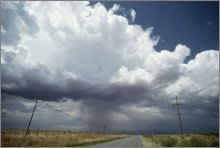Does "Seeding" Clouds with Silver
Iodide Really Make it Rain?
by www.SixWise.com
In a time when water
shortages and drought are the norm in the western region
of the United States, cloud seeding has emerged as a bit of
a modern-day rain dance.
|

Water shortages across the globe are forcing scientists
to take control of the whether -- in hopes of making
it rain or snow.
|
If you haven't yet heard, cloud seeding is a form of whether
modification that involves "seeding" clouds with
silver iodide, salt or dry ice in the hopes of increasing
the size of water or ice particles in the clouds to, ultimately,
get more rain.
It was developed in 1946 by Bernard Vonnegut, a scientist
(and, yes, the brother of famous author Kurt). Since then,
the United States has devoted millions of dollars to developing
it. In fact, it was even used to increase rain along the Ho
Chi Minh Trail during the Vietnam War so supplies would be
harder to transport.
Although cloud seeding has been used to alter fog (systems
are in use to modify fog at several major airports), hail
(to protect crops from damage), wind and lightning, most projects
are done to enhance either rain or snowfall (and therefore
increase spring runoff).
Does Cloud Seeding Work?
Cloud-seeding projects have been developed in 43 countries,
including the United States, Australia, Saudi Arabia, Italy,
West Africa, Mexico, China, and the United Arab Emirates,
according to the World Meteorological Organization. But do
they actually work?
According to the Utah Division of Water Resources, yes. They
say that winter seeding projects in the state generally increase
winter precipitation by 14 percent to 20 percent.
And as for costs, which range anywhere from $7 to $18 per
acre-foot, according to the Nevada State Cloud Seeding Program,
"the benefits from the extra water far outweigh the operational
costs of seeding," says Utah's Division of Water Resources.
That said, the University Corporation for Atmospheric Research
(UCAR) points out the cloud seeding is "big business."
States in the arid regions of the United States spend millions
of dollars (usually paid to private "cloud-seeding specialists")
every year in the hopes of getting more rain, and the results
proving cloud seeding's effectiveness, according to UCAR,
have been inconclusive.
|

Cloud seeding may increase winter precipitation by
14-20 percent, but studies are still underway to determine
if this is a real benefit, or just the normal variance
of natural weather.
|
Assuming cloud seeding does produce rain as planned, the
pay offs could be huge.
A 10 percent increase in snowpack in a targeted area would
provide between 130,000 and 260,000 acre-feet of water in
additional runoff each spring, according to The Wyoming Water
Development Commission (WWDC).
The extra water is valued anywhere between $2.4 million and
$4.9 million, and costs $6.60 to $13.00 per acre-foot -- much
cheaper than other water in Wyoming (water from Wyoming's
High Savery Dam costs $158.93 per acre-foot, according to
the WWDC).
Is This Really Natural, or Are There Unforeseen "Side
Effects"?
Not everyone agrees that cloud seeding is a good idea. Skeptics
claim that cloud seeding works because it's done in clouds
that are more likely to produce rain anyway, while others
fear whether modification could one day be used in "eco-terrorism"
-- as a weapon or method to create natural disasters at will.
However, according to the Utah Division of Water Resources,
"no significant environmental effects" have been
noted due to cloud seeding, "including projects of 30
to 40 years duration."
Still, some people maintain that it's risky to tamper with
the natural order of the weather.
"People are sometimes concerned about changing what
they think is natural weather," says National Center
for Atmospheric Research (NCAR) project scientist Dan Breed,
"but studies have shown that in some areas we're already
affecting clouds unintentionally through increases in airborne
particulates and other pollution."
"If cloud seeding is shown to work," he adds, "it
may help counteract the effects of air pollution as well as
ease those of natural drought cycles."
Wyoming currently has a project underway that they hope will
put an end to the controversy over cloud seeding -- via an
experiment using "sophisticated scientific evaluation."
"The challenge is to determine whether snowfall levels
would have occurred anyway, or clearly resulted from the seeding,"
says NCAR scientist Roelof Bruintjes. "Even a 10% increase
would fall within the range of natural variability of a single
storm or a whole season."
"To attribute cause," Bruintjes adds, "we
need this kind of careful, objective analysis independent
of the operations."
As it stands, Idaho, Utah, Nevada, California, Colorado,
New Mexico, North Dakota, Wyoming, Kansas, Oklahoma and Texas
are all either using or experimenting with whether modification
programs, including cloud seeding.
Recommended Reading
The
Water Shortage Crisis in America & the World: A Quick
Overview of One of the Most Dangerous Crises Humankind has
Ever Faced
Severe
Weather: The Most to Least Fatal & the Key Steps to Save
Your Life
Sources
Time.com
Utah
Division of Water Resources
The
University Corporation for Atmospheric Research
Nevada
State Cloud Seeding Program
North American
Interstate Whether Modification Council